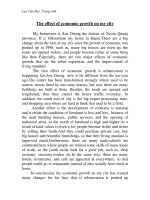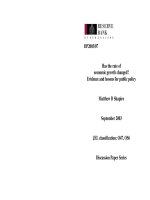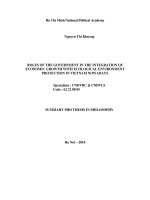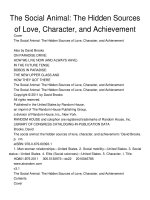Why australia prospered the shifting sources of economic growth
Bạn đang xem bản rút gọn của tài liệu. Xem và tải ngay bản đầy đủ của tài liệu tại đây (2.57 MB, 299 trang )
www.ebook3000.com
Why Australia Prospered
THE PRINCETON ECONOMIC HISTORY
OF THE WESTERN WORLD
Joel Mokyr, Series Editor
A list of titles in this series appears at the back of the book
www.ebook3000.com
Why Australia Prospered
The Shifting Sources of Economic Growth
Ian W. McLean
Princeton University Press
Princeton and Oxford
Copyright © 2013 by Princeton University Press
Published by Princeton University Press, 41 William Street, Princeton, New Jersey 08540
In the United Kingdom: Princeton University Press, 6 Oxford Street, Woodstock, Oxfordshire
OX20 1TW
press.princeton.edu
All Rights Reserved
Library of Congress Cataloging-in-Publication Data
McLean, Ian W.
Why Australia prospered : the shifting sources of economic growth / Ian W. McLean.
p. cm. — (The Princeton economic history of the Western world)
Includes bibliographical references and index.
ISBN 978-0-691-15467-1 (hardcover)
1. Economic development—Australia. 2. Australia—Economic policy—21st century. I. Title.
HD82.M3345 2013
338.994—dc23
2012008056
British Library Cataloging-in-Publication Data is available
This book has been composed in Minion Pro
Printed on acid-free paper. ∞
Printed in the United States of America
10 9 8 7 6 5 4 3 2 1
www.ebook3000.com
Contents
List of Figures
ix
List of Tables
xi
Preface and Acknowledgments
xiii
Map
xvi
Chapter 1
Introduction: Weaving Analysis and Narrative
1
Chapter 2 What Is to Be Explained, and How
Comparative Levels of GDP Per Capita
Booms, Busts, and Stagnation in Domestic Prosperity
Other Indicators of Economic Prosperity
From Evidence to Analysis
Extensive Growth and Factor Accumulation
Growth Theory and Australian Economic Historiography
Recent Themes in Growth Economics
11
11
15
19
25
27
29
32
Chapter 3 Origins: An Economy Built from Scratch?
The Pre-1788 Economy of the Aborigines
The Aboriginal Contribution to the Post-1788 Economy
The Convict Economy and Its Peculiar Labor Market
Further Features of the Economy Relevant to Later Prosperity
British Subsidies and Australian Living Standards
37
38
42
44
50
53
Chapter 4 Squatting, Colonial Autocracy, and Imperial Policies
Why the Wool Industry Was So Efficient
Evolution of Political Institutions: From Autocracy to Responsible
Government
The Labor Market: Ending Transportation, Preventing Coolie
Immigration
Thwarting the Squatters: Land Policies to 1847
Other Determinants of Early Colonial Prosperity
The Argentine Road Not Taken
57
58
Chapter 5 Becoming Very Rich
The Economic Effects of Gold: Avoiding the Resource Curse
Sustaining Economic Prosperity Following the Rushes
80
84
90
63
67
69
73
76
vi
•
Contents
Consolidating Democracy and Resolving the Squatter-Selector
Conflict
Openness and Growth
Rural Productivity and Its Sources
96
100
108
Chapter 6 Depression, Drought, and Federation
Explaining Relative Incomes
Eating the Seed Corn?
Boom, Bubble, and Bust: A Classic Debt Crisis
Why Was Recovery So Slow? Comparison with Other Settler
Economies
Tropics, Crops, and Melanesians: Another Road Not Taken
Economic Effects of Federation
Accounting for the Loss of the “Top Spot” in Income Per Capita
113
113
116
119
Chapter 7 A Succession of Negative Shocks
Why Was the Economic Impact of World War I So Severe?
Why No Return to Normalcy?
Pursuing Rural Development—A Field of Dreams?
Growth in Other Settler Economies
Debt Crisis, Then Depression—Policy Responses and Constraints
Imperial Economic Links—Declining Net Benefits
Could the Post-1960 Mineral Boom Have Occurred Earlier?
The Debate over Stagnant Living Standards
144
147
148
154
157
160
165
170
173
Chapter 8 The Pacific War and the Second Golden Age
Why the Pacific War Fostered Domestic Growth
The Golden Age Was Not Uniquely Australian
Export Growth, Factor Inflows, and the Korean War Wool Boom
Macroeconomic Theory and Policies—What Role?
Location Advantage: Asian Industrialization and Changing Trade
Partners
High Tide for Australian Industrialization
Underinvestment in Human Capital?
The Debate over Postwar Growth Performance
176
177
183
186
191
Chapter 9 Shocks, Policy Shifts, and Another Long Boom
Why Did the Postwar Economic Boom End?
The Reemergence of a Booming Mining Sector
Macroeconomic Management in the 1970s
Economic Policy Shifts in the 1980s
Reevaluations
The Quarry Economy: The Return of Resources-Based Prosperity
The Contribution of Economic Reforms to Productivity
210
212
215
217
219
224
228
235
www.ebook3000.com
125
132
135
139
193
196
199
205
Contents
Sustaining Prosperity through Boom and Bubble—A Historical
Perspective
Chapter 10
Appendix
The Shifting Bases of Prosperity
Note on Statistics and Sources
•
vii
241
246
257
References
259
Index
277
www.ebook3000.com
Figures
Figure 2.1
Figure 2.2
Figure 2.3
Figure 2.4
Figure 4.1
Figure 5.1
Figure 5.2
Figure 5.3
Figure 6.1
Figure 6.2
Figure 6.3
Figure 6.4
Figure 7.1
Figure 7.2
Figure 7.3
Figure 7.4
Figure 8.1
Figure 8.2
Figure 8.3
Figure 8.4
Figure 8.5
Figure 9.1
Figure 9.2
Comparative GDP per capita, selected years, 1820
to 2008.
Population increase per decade, 1790 to 2009.
Growth rate of GDP per capita by period, 1850
to 2010.
Distribution of top incomes, 1921 to 2003.
Wool trade, 1822 to 1850.
Mining shares of total employment and GDP, 1849
to 2009.
Export and trade ratios, 1825 to 2009.
Government debt as a percentage of GDP, 1854
to 1914.
GDP per capita, 1889 to 1914.
Foreign debt-servicing ratio, 1861 to 1983.
Victoria: government revenue, expenditure, and deficit,
1890 to 1914.
Growth indicators: Argentina, Australia, and Canada,
1890 to 1913.
Alternative estimates of GDP per capita, 1914
to 1939.
Government debt as a percentage of GDP, 1901
to 1962.
Tariff protection, 1904 to 2005.
Unemployment rate, 1901 to 2010.
Manufacturing shares of total employment and GDP,
1891 to 2009.
Immigration indicators, 1925 to 2007.
Terms of trade, 1870 to 2009.
Shares of total exports to Japan and the U.K., 1949
to 1989.
Comparative education participation rates at ages
16 and 17, 1910 to 1971.
Annual growth rate of GDP per capita, 1951
to 2010.
Australia’s percentage of world “economic
demonstrated resources” of major minerals,
December 2008.
12
17
19
22
59
91
101
106
114
122
129
130
145
151
153
162
181
187
189
195
202
212
230
x • Figures
Figure 9.3
Figure 9.4
Figure 9.5
Figure 10.1
Mining investment as a percentage of GDP, 1861
to 2009.
GDP per capita adjusted for the terms of trade, 1960
to 2010.
Estimated contributions to growth in real aggregate
gross domestic income, 1970 to 2009.
Comparative GDP per capita and comparative HDI
rankings, 2010.
www.ebook3000.com
231
232
237
247
Tables
Table 2.1
Table 7.1
Economic and population growth rates by period, annual
average percentages, 1850 to 2010.
16
Social indicators, 1891 to 1947.
174
www.ebook3000.com
Preface and Acknowledgments
This book had its origins in the spring of 2006 in an office affording a breathtaking view across San Francisco Bay and through the Golden Gate to the Pacific beyond. This was an especially appropriate vantage point for the task. If
California were a national rather than a regional economy, it would receive more
frequent comparison with Australia, for it shares with its fellow settler economy
on the far side of the Pacific many initial conditions relevant to its early prosperity, in addition to having a similarly enviable record of subsequent growth.
More generally, observing Australian experience from outside the country
heightens one’s perception both of what seems noteworthy or unusual—thereby
warranting greater consideration than it might otherwise attract—and of what
seems unexceptional.
I wanted to reflect on what is surely one of the most striking features of Australia’s history: its early attainment, then retention over a century and a half, of
a very high level of economic prosperity. My aim was to view this achievement
not only within the context of the ever-changing international economy, which
has exerted such a pervasive influence on the country’s economic history, but
also in a comparative perspective, drawing especially on the experience of other
settler economies—in particular Argentina, Canada, New Zealand, and the United
States.
Another objective in writing this book has been to help fill a lacuna in discussions of the remarkable period of prosperity Australians have experienced
since the last (technical) recession in the economy in 1991. Most attention in
the media understandably focuses on short-run movements in key economic
or financial indices, or on political aspects of whichever economic policy issue
has fleetingly caught the attention of the public. It is less common to observe
space devoted to providing context—historical and comparative—as to why
Australia, virtually alone among the advanced economies, has enjoyed this extended period of uninterrupted growth. To gain more than a superficial understanding of the economy’s performance during this recent period, I argue that it
is necessary to adopt a perspective encompassing much of the country’s history.
Many debts have been accumulated in the course of writing. Conversations
at the design stage with Barry Eichengreen, Rui Esteves, and Kris Mitchener
were especially helpful. Subsequent development of the ideas and material benefited from the comments of Raj Arunachalam, Brad DeLong, Bob Gregory,
Tim Hatton, Douglas Irwin, Suresh Naidu, James Robinson, Gavin Wright, and
conference and seminar participants at the University of Adelaide, the University of California, Berkeley, and the University of Melbourne. Kelly Wyett
xiv
•
Preface and Acknowledgments
of the Reserve Bank of Australia assisted with data sources. Daniel Mabarrack
provided superb research assistance in the final preparation of the manuscript.
I am especially indebted to Jeff Borland, Robert Dare, and Richard Pomfret,
who made invaluable and detailed comments on an earlier draft. Joel Mokyr’s
many contributions greatly improved the final product. Finally, I am grateful
to Seth Ditchik at Princeton University Press for his editorial support, and to
Karen Carter and Marsha Kunin for their production and copy-editing skills,
respectively.
My greatest debt is to Barry Eichengreen and the Department of Economics
at Berkeley, who, across the last decade and a half, have generously facilitated
my recurrent membership in the group of economic historians among the faculty and graduate students there. These colleagues have helped shape much of my
research during this period, some of which is reflected in the following pages.
Adelaide, December 2011
www.ebook3000.com
Why Australia Prospered
Darwin
Cape York
Kimberley
Cairns
NORTHERN
TERRITORY
Port Hedland
Pilbara
Mt Isa
QUEENSLAND
WESTERN
AUSTRALIA
Brisbane
SOUTH
AUSTRALIA
Olympic Dam
Perth
Kalgoorlie
Whyalla
COMMONWEALTH OF
AUSTRALIA
Broken Hill
NEW SOUTH
WALES
Newcastle
Sydney
Adelaide
Ballarat
Canberra (ACT)
VICTORIA
Melbourne
500 km
300 mi
TASMANIA
Hobart
www.ebook3000.com
CHAPTER 1
Introduction
Weaving Analysis and Narrative
Australian history is almost always picturesque; indeed, it is so curious and
strange, that it is itself the chiefest novelty the country has to offer, and so it pushes
the other novelties into second and third place. And it does not read like history,
but the most beautiful lies. And all of a fresh new sort, no mouldy old stale ones.
—Mark Twain1
Australians attained the highest incomes in the world by the mid-nineteenth
century, only a few decades after European settlement. Despite losing that remarkable position around 1900, they have retained to the present a standard
of living that is not appreciably exceeded elsewhere. Few economies have been
as successful over so long a period.2 Some have achieved comparable levels of
income only since the Second World War (think of Japan or Italy). Many are
currently making good progress in catching up to these levels, though still have
some distance to travel (think of South Korea). One has experienced long-term
relative decline after having achieved membership into the rich club of nations
in the early twentieth century (Argentina). Tragically, many less-developed
economies have managed only low or intermittent growth such that they have
not even begun to close the gap between their living standards and those of the
richest countries. What explains Australia’s enviable record of prosperity?
•
•
•
This inquiry into why Australia is rich adopts a historical approach because
the roots of prosperity are embedded in the past: the levels of income observed
in the currently rich economies are in every case the result of very long-run
processes. Economies do not move rapidly from poverty and backwardness to
advanced industrial status and concomitant prosperity despite the achievements of
1
Twain (1989 [1897]), p. 169.
The richest countries over the last 150 years include, in addition to Australia, the United
States and Britain throughout; and the Netherlands, Canada, New Zealand, and Switzerland for
much, but not all, of this period. See Prados de la Escosura (2000) for a review of alternative
historical estimates of per capita income for the currently rich economies.
2
2
•
Chapter 1
some being described as “economic miracles.” Even with the impressive growth
rates recently recorded in a number of poor countries such as India and China,
attaining incomes comparable to the rich countries takes many decades. This is
partly because incomes in the rich countries have also been rising: the poor
countries must thus catch up with a level of prosperity that is moving ever
higher. To illustrate, Japan began its modernization in the second half of the
nineteenth century and is regarded as having turned in perhaps the most rapid
growth performance among the currently advanced economies. But it was not
until the late twentieth century that it attained approximate parity with incomes
in the leading economies. And the evidence suggests that the level of economic
development in nineteenth-century Japan was already beyond that of many less
developed countries today. Or consider the roots of Britain’s economic prosperity by 1850 at the end of the first industrial revolution. Historians long ago
agreed it was a phase of growth that was evolutionary rather than revolutionary,
and have traced its origins to an array of constitutional, social, demographic,
scientific, technological, and cultural as well as economic developments stretching back several centuries.3 Thus the importance given here to historical influences in an explanation of present-day prosperity is not something unique to
the case of Australia. Economists increasingly draw on history in their quest to
better account for why some countries are rich and others poor.4
There is an added reason to look to history to account for Australia’s economic prosperity. Unlike Japan and much of Europe, membership in the rich
club of nations is not a recent phenomenon. Hence the task set by posing the
question “Why is Australia rich?” may be better posed as two questions to
be addressed sequentially: Why was Australia so rich by the second half of
the nineteenth century? And how has Australia managed to retain its position
among the richest group of countries over the subsequent 150 years? Whether
the answer to the first question differs from the answer to the second can be
established only by historical inquiry.
The need for a historical perspective arises also because any persuasive
explanation for Australia’s current high-income status must highlight longestablished features of its economy and society. In particular, prominence must
be accorded certain of its economic and political institutions whose origins, in
some cases, stretch back to the beginning of European settlement at the end of
the eighteenth century. Since these institutions were adopted—or adapted—
largely from British designs, their historical roots are even deeper.
The story of Australia’s success in first achieving then maintaining its relatively high levels of economic prosperity over the past two centuries will here
be told primarily in terms of the average levels of income per capita achieved in
successive periods (usually of two or three decades) relative to that attained in
3
For recent overviews and interpretations, see Allen (2009), Clark (2007), and Mokyr (2009).
Surveys covering many countries and several centuries include Jones (1987), Landes (1998),
and Pomeranz (2000).
4
www.ebook3000.com
Analysis and Narrative • 3
previous periods, and also compared to the best achieved in other countries at
the time. The prosperity attained in any period represents either some improvement over the previous period, some slippage, or stagnation, and our aim is to
explain why we observe the outcome we do. Adding the cross-country dimension to our assessment is vital: Australia’s economic achievements only have
adequate context when compared with those of other countries.
Thus, one aim is that this study contribute to the literature on comparative
growth, especially its historical dimension, a literature that has burgeoned in
recent years. For their part, economic historians increasingly employ a comparative approach in their research.5 And growth economists are finding not
just that policies that successfully promote growth are proving harder to identify than believed by earlier generations of development economists, but that
the reasons for growth—and particularly for its absence—in many cases appear
to be related to factors specific to an economy’s historical background. A historical case study, wherein the questions are framed such that the findings may
readily be integrated with the results from other approaches to the analysis of
growth, can thus make a contribution to this pressing policy challenge.
Adopting this approach, it follows that many themes or topics that would
deserve attention in a general review of Australian economic history will be
passed over lightly, or completely ignored. They will only be addressed insofar
as they are relevant to an inquiry into the reasons for the levels of prosperity
achieved. Thus no claim is made that this is a comprehensive or balanced account of the historical development of the Australian economy. Instead, my
further aim is to provide those Australians who are curious about their own
good fortune with an explanation for what surely ranks as one of their country’s
most remarkable achievements. And although there is a substantial body of
writing on many aspects of the history of the economy, as will quickly become
clear, no previous writer has adopted the present focus in an extended inquiry
into the reasons for Australia’s sustained prosperity.
This history is therefore part analysis, part narrative. The balance I strike between the two is intended to ensure the discussion remains accessible to a wider
audience. And it is for this reason that I keep the use of technical terms and
references to theory to a minimum, and for the most part confine my reporting
of historical statistics to a limited number of simple charts.
•
•
•
The roots of current economic prosperity are not only located in the past, they
are also complex. Given this, some explanatory framework is required to identify the key elements in any growth narrative, to determine how much prominence each is assigned, and to relate them to one another. Of course, explaining
5
The approach is well illustrated by the studies in the recent collection edited by Hatton,
O’Rourke, and Taylor (2007).
4
•
Chapter 1
nearly two centuries of Australian economic prosperity would be less challenging were economists in possession of a theory of economic growth of universal
validity—that is, for which there existed robust empirical support across all
countries and at all times. They are not. But it is from the growth literature that
I derive some of the insights into Australia’s experience offered in this book.6
In the immediate postwar years, growth theory highlighted investment in
physical capital as perhaps the single most important source of variation in rates
of growth in an economy. Since then, differences in growth rates have also been
attributed to differences in rates of human capital accumulation, especially formal education. And the rate of technological change completes this trinity of
the sources of growth, which theory assigned a prominent role—the myriad
ways in which a given level of output may be achieved with fewer inputs as a
consequence of the diffusion of productivity-raising innovations.
There are two reasons why this trinity will not be center stage in this account. First, this is primarily an inquiry into the reasons for Australia’s level of
economic prosperity (conventionally defined as income or GDP per capita).
To observe that a high-income country has more highly educated workers, and
that they each use more equipment, provides no more than a superficial explanation as to why that country is rich: indeed such evidence is better interpreted
as a corollary or a symptom of the level of its prosperity. Rather, it is necessary
to ask why we observe so much more physical and human capital per worker in
high-income than in low-income countries. That is, a set of more fundamental determinants of growth must be sought to account for the extremely wide
variation in the levels of productivity and hence incomes across countries. And
to do this, economists now look more deeply into the mechanism of growth—
such as to aspects of the endowment (including natural resources, climate, location), institutional quality (the legal system, corruption, political arrangements,
property rights), key policies (such as openness to trade, and intervention in
markets), and cultural attributes (social norms, religion). I will explore these
further in chapter 2 in discussing their relevance to the Australian experience.
The second reason for paying less attention to the proximate sources of
growth is that we are focusing on the very long run—why prosperity has been
sustained for nearly two centuries. If this inquiry were limited to a period within
which the institutional framework, resource endowments, and other deeper influences could safely be assumed not to change, then it would be appropriate
to confine attention to the immediate determinants of growth, in particular
those that were amenable to policy. In the short run, fluctuations in the rate of
growth of Australia’s economy are likely to be influenced most powerfully by
such factors as variations in the savings rate, business and consumer sentiment,
the rate of immigration, and the expected profitability of new investment. Over
the long run, however, many of the influences determining the level of income,
6
I will have more to say about this literature in chapter 2.
www.ebook3000.com
Analysis and Narrative • 5
but held constant in most theories of growth, cannot be ignored. They become
the items of greatest interest.
One feature of the Australian experience that I therefore accord special significance is the natural-resource base—especially farmland and minerals. This
economy is resource abundant in the sense of possessing a high ratio of natural
resources relative to its population or labor force. In its early history, the resource sector provided much of the economy’s output and was an important
source of employment. More striking is that, for all of its history, exports have
been dominated by a succession of resource-intensive products beginning with
wool and gold. After more than 150 years of sustained high incomes, the comparative advantage of this economy still lies in its natural resources—around 65
percent of current exports are primary products. Australian history therefore
offers compelling evidence against the widely held view that resource abundance is a curse not a blessing, and typically associated with corruption, low
growth or stagnation, and even failed states.7
A second feature emphasized in the interpretation offered here is the quality
of the institutional arrangements within which the economy operated. Economists recognize that institutions play a major role in explaining which countries
are rich and which are not.8 Australia is no exception to this generalization. Its
sustained economic prosperity cannot be accounted for without giving priority
to the role of certain institutions whose contribution has not always been appropriately recognized. In this growth narrative, several roles are emphasized.
One is that Australian history yields some vivid illustrations of the importance
of institutional flexibility. More than once, as evidence accumulated that an
institution was operating in a manner harmful to prosperity, it was either abolished or modified to make it growth promoting. Nineteenth-century examples
considered below include the transportation of convicts, the monopolization of
grazing land by squatters, and the employment of immigrant, indentured labor
on sugar plantations. A recent example is the reform of labor-market institutions that came to be seen as holding back potential productivity gains. The capacity of a society to adapt its institutional arrangements in the face of changed
economic conditions, or evidence of the adverse consequences for prosperity
of doing nothing, is a key factor explaining why there is such a wide range of
income levels across countries.
Another role of institutions in this story is that political (including constitutional) arrangements likely played a key part in sustaining prosperity. One
example has been of interest to political historians but less so to economists.
The Australian economy has its origins as a component of the British Empire.
Whereas the economic costs of imperialism in general have long been debated,
7
I will have more to say on the resource-curse hypothesis in the next chapter.
For a survey of the literature on institutions and growth, see Acemoglu, Johnson, and Robinson (2005).
8
6
•
Chapter 1
there is no evidence of sustained or serious economic exploitation of Australia
by the British. To the contrary, the Australian colonies benefited greatly from
their participation as integral components of the world’s most dynamic and
advanced economy at that time. They had privileged access to the main market
for foreign capital, and secured special trading privileges. At the political level,
self-government came early and bloodlessly to the small European population
in five of the six colonies in the 1850s. They in turn devised first their own constitutions and later a federal constitution for their unification in 1901, and these
have served the economy well.
A final role of institutions that is emphasized in what follows is their interaction with resource abundance. In recent decades, to be resource rich appears
typically to have led to slower growth in developing countries. This is puzzling.
In theory, having more resources should raise the level of economic prosperity.
Economies that are both resource rich and prosperous are therefore important
counterexamples to the prevailing resource-curse hypothesis, and Australia
throughout its modern history clearly fits this description. I explain the absence
of a resource curse primarily in terms of the quality of some of the country’s key
institutional arrangements. How they were formed, how well they functioned,
and how responsively they evolved in the light of experience or changed circumstances, largely determined whether the natural-resource base would be
exploited in a manner that was growth promoting or wasteful of these natural
assets. That is, the conditions of access to, the specification of property rights
in, and the distribution of rents from the natural-resource endowment are what
determined whether the growth effects of resource abundance were positive.
Just one example from later discussion is the set of rules under which farming
or mining could be conducted on Crown land.
In this account of the Australian economy’s sustained prosperity, I also emphasize the manner in which its policy-makers responded to the major economic
shocks—positive and negative—that have punctuated its history. Sometimes
the shocks originated within the resource sector, such as with the discovery of
gold. As noted, a favorable shock of this type need not necessarily underpin
prosperity if appropriate institutions are lacking. On other occasions the shocks
were negative and arose from elsewhere—the First World War, the interwar
collapse of the world economy, or the oil price hikes of the 1970s. Then the critical issue is how well existing institutions coped with stress and adversity, and
what policies were put in place in response to the deterioration in the economic
environment. Chance events of short duration have on occasion shaped the
trajectory of the economy over much longer periods. In general we will observe
an economy resilient to shocks, together with policy choices made in their aftermath that were appropriate to sustaining prosperity.
One major shock to the economy widely believed to have had profound
long-run implications was the depression of the 1890s. It appeared then that
www.ebook3000.com
Analysis and Narrative • 7
resource-based prosperity had faltered, and that the openness of the economy
had heightened its vulnerability to destabilizing global forces. Some historians
identify a fundamental shift in economic and social policies as the eventual
response. The new strategy for economic growth was designed to reduce the
dependence of the economy on its resources sector and on imports, thereby
reducing the exposure of the community to economic fluctuations emanating
from abroad. Implementing these policies required the creation of new economic institutions, especially in the labor market. The consequence was a strategy of industrialization behind rising levels of protection that was pursued for
half a century. Though influential, this interpretation will be shown to require
modification.
This book does not, however, simplify what is a complex history of growth
to an explanation focusing solely on the interactions between resource abundance, the quality of institutions, and the development policies adopted in response to major economic shocks. Other hypotheses, themes, and conjectures
feature in the narrative, countering any tendency to the overly reductionist approach to historical explanation that can follow uncritical adherence to the suggestions of any single and parsimonious theory. To illustrate with an example
appropriate in a history of the so-called lucky country, due recognition is given
to the role of chance.
Two other elements of the approach adopted in this inquiry warrant early
mention. I do not believe a persuasive account of Australia’s economic growth
can be conducted as if this growth were sui generis. It is vital not to miss that
which only comes into focus on looking in the mirror provided by experience
elsewhere. Obviously, in its entirety the Australian story is unique. But examining the experience of other economies greatly assists thinking about many
features of the Australian case. My choice of comparator will vary according to
the issue and period. Until recent decades it will most often be made by consulting some aspects of the history of the other settler economies of Canada,
Argentina, New Zealand, and the United States (especially its western regions).
Australia has more in common with the geography, factor endowment, and
patterns of demographic and economic development in these countries than
it has with those observed in Britain, Continental Europe, or Japan. For recent
decades comparisons with a wider set of countries and with OECD averages are
often more appropriate.
I also make use of counterfactuals as devices to aid thinking about what actually happened. This approach to historical research has limitations, and will not
be formally developed in relation to any issue. But posing a plausible counterfactual in order critically to assess the significance of an event or policy can be a
useful thought experiment. And one way counterfactuals can be made especially
apt is by drawing on comparative experience. If relevant conditions are roughly
comparable in another economy, it is likely a counterfactual assessment of some
8
•
Chapter 1
aspect of Australian experience can be more persuasive and better illuminate
what actually occurred.
•
•
•
To provide context for what follows, I first set out the evidence of economic
prosperity (chapter 2). This covers the entire era of European settlement, and
includes comparisons with the performance of selected other countries. Particular attention is paid to alternative measures of prosperity, their relationships to
one another, and their limitations. As a first step toward the explanation of this
evidence, I briefly review existing suggestions as to what are likely the most important determinants of Australia’s levels of productivity and living standards.
There are several literatures of relevance here, especially those on Australian
history, comparative economic history, and growth economics—both theoretical and empirical.
I then take up the historical narrative, beginning with an assessment of the
Aboriginal contribution to the economy constructed by the first European settlers at the end of the eighteenth century and beginning of the nineteenth. The
British military, convict workforce, and British government financial outlays
laid the early foundations of a tiny local economy at the outer margins of a
vast imperial project (chapter 3). From the 1820s Australia’s prosperity rested,
initially, on the productivity of its labor force—convicts, emancipists, and free
immigrants—and the occupation and exploratory utilization of a large area of
natural grassland primarily for the production and export of wool (chapter 4).
This geographical settlement and pastoral development occurred in a rapidly
evolving institutional setting. Both in the economic and political spheres, institutional innovation and adaptation appears successfully to have underpinned
the attainment of quite high incomes per capita even before the discovery of gold.
The gold rushes beginning in the 1850s brought not only a diversification of
the economic basis of prosperity beyond that provided by the wool industry,
but coincided with the de facto political independence of five of the Australian colonies through their attainment of responsible government from Britain.
Critical to the maintenance and extension of prosperity during these turbulent
years was the way in which the shock to the economy of the gold discoveries was mediated by the evolving economic and political institutions. The gold
rushes were no flash in the pan. Gold continued to be important to prosperity
for several decades, while a resumption of the expansion of the wool industry
was matched by the development of other branches of agriculture (chapter 5).
This is the period in which Australia came to record the world’s highest income
levels.
After 1890, however, these very high levels of relative prosperity were not sustained. Negative shocks from internal imbalance, external factors, and drought
wrought havoc with the economy for more than a decade (chapter 6). Against
www.ebook3000.com









